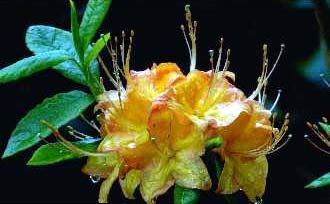A peat bed is a bed for acid-loving plants such as the ever-popular rhododendrons, which need moist, acidic soil to flourish. It contains a high proportion of peat and sand, and it rises inches above ground level.
Not a few home gardening enthusiasts discover to their dismay that their magnificent rhododendrons and azaleas turn yellow after a while and fail. And this happens despite the fact that they have faithfully followed the advice of many gardeners to mix extra amounts of peat with the planting soil and to supplement the peat content yearly.
This advice, while correct as far as it goes, is not enough to meet the needs of acid-loving plants. Peat contains the acid that rhododendrons and azaleas need. But peat disintegrates in time – rain washes it away - and run-off from a surrounding bed may bring in lime, which rhododendrons and azaleas cannot tolerate. Then, incorrect feeding (with fertilizer containing insufficient acid) takes a further toll.
The solution is to plant rhododendrons and azaleas in the right location and in a special peat bed.
The Right Location
Plants that are candidates for a peat bed are ones that prefer cool, semishaded locations where the underlying soil stays uniformly moist, and where they are protected from harsh noonday sun. A location in the dappled shade of tall shrubs and trees in the shade cast by a wall is ideal. Conifers of all types provide an excellent background for rhododendrons and azaleas, and they protect them from cold winds at the same time.
The Soil
There are many garden plants that prefer acid-rich soil and thrive in peat beds. Besides azaleas and rhododendrons, there are ferns, heathers, camellias, and American laurels. But only in the right kind of soil will peat bed plants find the right growing conditions. For these plants to do well in the peat bed, the soil must contain certain ingredients. It must have the right acid level and be rich in nutrients. The soil's pH level should be very low. A pH level of about 4 is just right.
The right nutrients depend to some extent on the pH level. Phosphorus and iron are abundantly present in acid soil. They are not present in alkaline soil. Their absence is responsible for nutrient deficiencies that cause plants to become chlorotic.
Acid soil has other qualities to which rhododendrons and azaleas are especially adapted. One of them is that acid soil usually holds water, and as a consequence stays moist and cool.
A peat bed requires that a special mixture be used as the substratum, a mixture generally consisting of peat, bark, compost, and sand. This mixture is tailored exactly to the needs of these plants. It contains loosening and binding substances; it lets in air; it does not become compacted; and it has excellent nutrient storage qualities.
Constructing the Bed
A well-prepared planting hole will meet the acid needs of 1 plant or even a few plants. But if you plan to cultivate many acid-loving shrubs and perennials together, the construction of a peat bed will prove advantageous.
Have your soil analyzed by a local horticultural extension service in advance so that you know exactly what kind of improvement is necessary. A soil analysis will tell you whether the soil contains enough acid and nutrients.
If your soil is already acid, you will need to do only a little amending. Excavate the soil 12 to 14 inches deep and twice the width of the root ball of the shrubs that are to be planted. Mix 1 part of this soil with 1 part peat and 1 part sand.
If your soil is essentially alkaline, you will have to expend a little more effort. In such soil merely excavating a planting hole will not be enough; sooner or later the roots of the plants will come in contact with the alkaline subsoil, the consequences of which will be plainly visible in chlorotic – that is, yellowed - leaves. Even if this should occur only after years of undisturbed growth, it would be a pity to lose any plants growing in the peat bed.
To prevent loss, line the sides of the planting hole with sheets of plastic. Line the bottom of the hole with a layer of spruce twigs to collect any lime.
TIPS: CORRECT FERTILIZING
Plants growing in a peat bed will not require a lot of supplemental fertilizer; the peat bed will provide most of the nutrients the plants will need. A good way to supply additional nutrients to the bed is to apply a layer of bark mulch. You will need to replenish the mulch about 3 months after planting and each year thereafter.
IMPORTANT
Many nurseries sell highly touted lime-tolerant rhododendrons that reportedly do well enough in predominantly alkaline soil. There are, of course, some species whose soil requirements are less demanding than others, but all rhododendrons, without exception, need acid soil. Do not deceive yourself into believing that rhododendrons will succeed in alkaline soil. You might have modest success for a short time, but after a few years even the hardiest plants will fail.
HOW TO CREATE A PEAT BED
1. Select a cool, partially shaded location, preferably one protected by large shrubs, trees, or a wall, and one that is shielded from cold winds and severe frost. The size of the bed depends on the number of plants.
2. Excavate a planting bole approximately 2 feet deep. Put down a 4-inch layer of evergreen boughs. Tamp down firmly. Line the sides of the hole with a sheet of plastic or with boards to a depth of 11/2 feet. Apply a 4-inch layer of growing medium consisting of 1 part topsoil, 1 part peat, and 1 part sand.
3. Set plants in the hole and backfill with this growing medium. Water, and then apply a layer of peat fertilizer on top. The bed should be approximately 2 to 4 inches higher than the surrounding ground.


